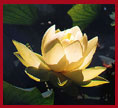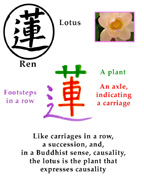
Ren is composed of three elemental characters — Hua, Chuan, and Cho.
|
Hua |
Hua is a radical indicating vegetation. It is composed of a horizontal line, with two smaller vertical lines crossing it. The horizontal line is the surface from which the plant emerges. In the case of the lotus, that surface is swampy water. The two vertical lines are contractions of a primitive that was an offering made with both hands. It is now construed as the plant itself emerging from the ground. |
|
Chuan |
Chuan in its primitive form is a yoke, meaning mastery. It is now a carriage. The carriage delivers riches, medicine, and honored persons. It is a treasure vehicle. |
|
Cho |
Cho is footprints, one after the other. It looks like a large "Z" with two dots above it. |
| Cho combines with Chuan, becoming carriages in a row, one after the other, or a succession. In a Buddhist sense, causality. Combining hua, cho, and chuan results in a plant that expresses causality — the Lotus. |
RENGE kyo |
 |
![]()
 |
|
---------------
Sources:
- Chinese Characters: Their origin, etymology, history, classification, and signification, by L. Weiger (1965) Paragon Books.
- The smaller Chinese characters (at top) are all from http://zhongwen.com/, the premiere Internet source for Chinese characters.
- The colored characters in the Diagram (above) were drawn by Angela Pun and Elizabeth Wang, without whose help this project would have faltered.